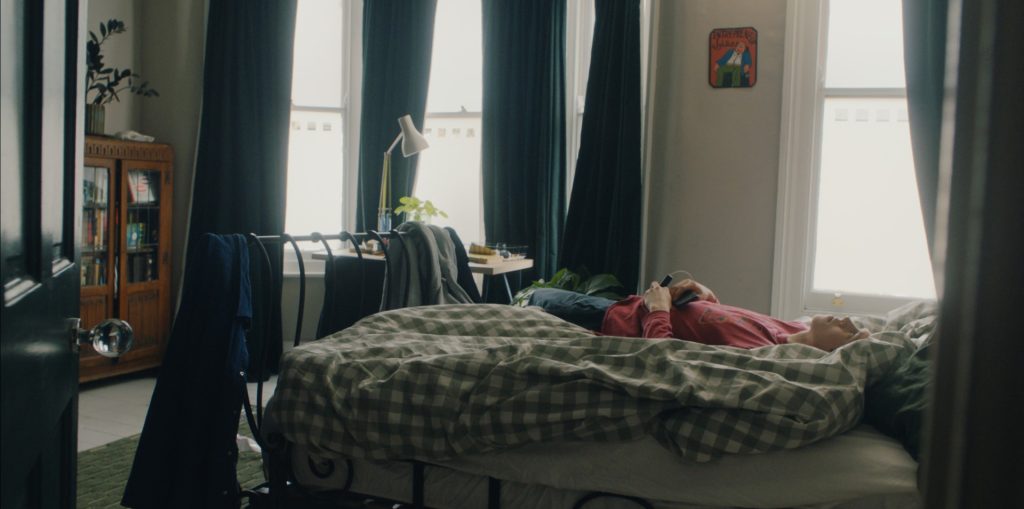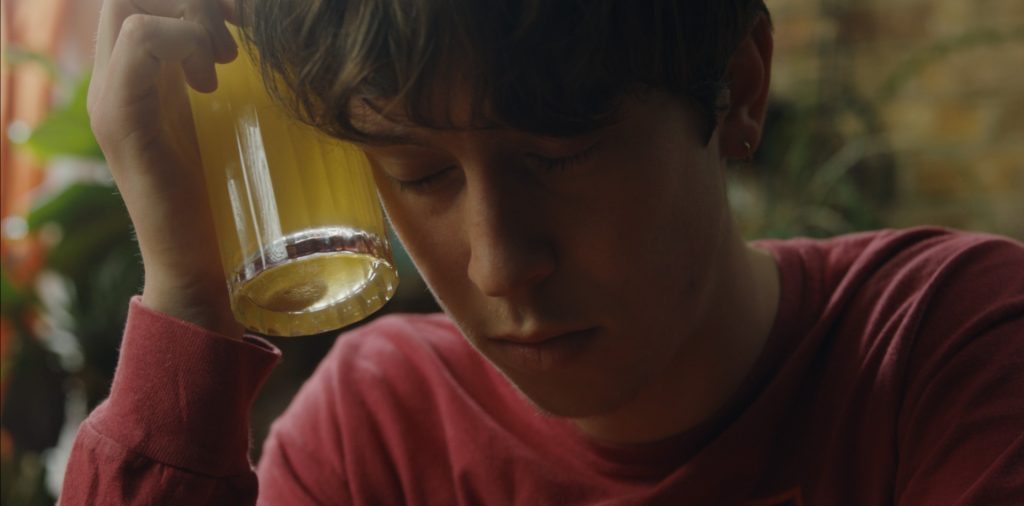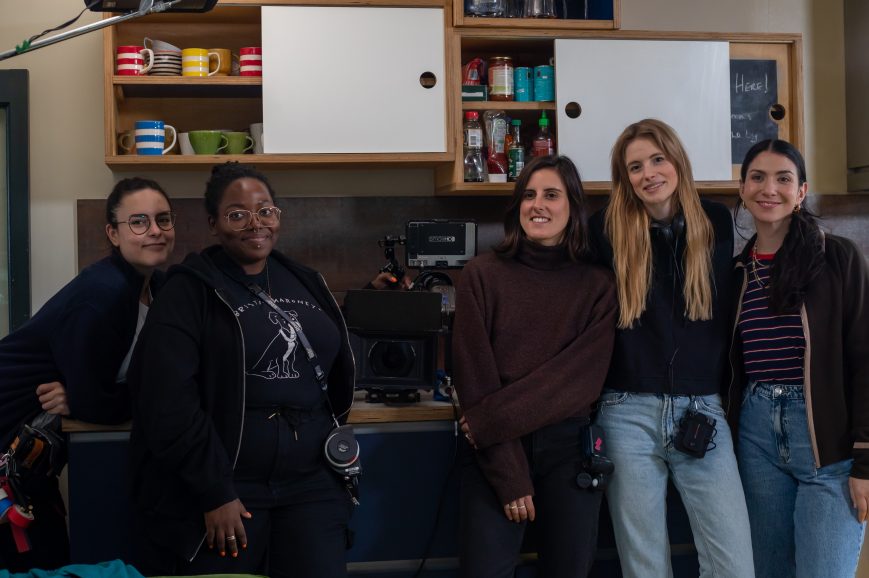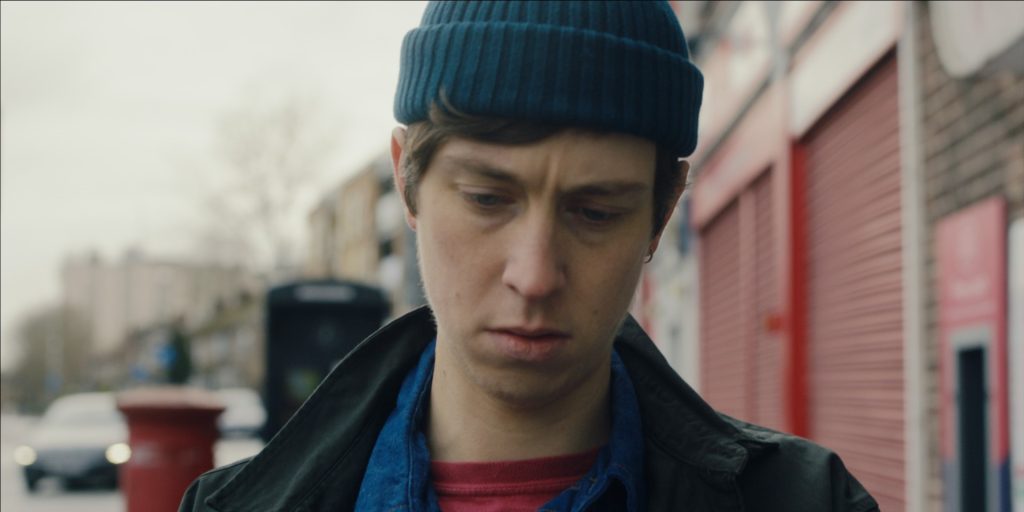The morning after
Cinematographer Carmen Pellon Brussosa on striking the perfect balance of comedy and drama in her lensing of gender-flipping short film Does Your Condom Make You Fat?
After a boozy night with his date, Owen wakes up to a big problem: his usual contraception has failed and he needs a solution – fast. In Does Your Condom Make You Fat?, debut screenwriter Danielle Papamichael spins the stigma of the morning after pill on its head in a wit-laced script set in a world where men can get pregnant.

“When Sophie [King, director] sent me the treatment for Does Your Condom Make You Fat?, I remember thinking, ‘God, this is such a good project,’” smiles cinematographer Carmen Pellon Brussosa.
Brussosa, who hails from Barcelona, moved to the UK to study and has been based in London for the last decade. Her bread-and-butter is commercials and shorts, but she also enjoys dipping her toes into the world of music video and eventually hopes to move into longform narrative.
She describes Does Your Condom Make You Fat? as a “very special story”, adding: “It’s so interesting how the film manages to put contraception and the responsibility women have with it into a very absurd and comical world, and without judgement. We’re not trying to make anyone feel ashamed; but rather tap into these undesired emotions we go through and to challenge perceptions around contraception.”

Helping hand
An exciting sponsorship opportunity from Girls in Film, Panavision and Panalux gave Does Your Condom Make You Fat? a welcome funding boost. The short is one of five projects that won the inaugural PANAGiF prize, a scheme giving five female, trans or non-binary cinematographers access to camera and lighting kit from Panavision and Panalux, along with technical guidance and support.
“The PANAGiF sponsorship came exactly at the moment we needed to close our financing,” says producer Siona Davis. She adds that F5 Films developed and produced the project, while Dolphragon was a key investor. “When we got the news [about the sponsorship] in January 2023 we were able to greenlight the shoot and were filming by March. Not only has it enabled us to get the film made but it’s been fantastic to work with the support of the team at Girls in Film (Becs Rainey, Lauren Mills and Anne-Sofie Lindgaard), who facilitated a workshop for Carmen, as well as the generosity of Panavision and Panalux (Victoria Harris, Kate Priestman and George Martin).”

As part of the prize package, Panavision supplied Pellon Brussosa with the ARRI Alexa Mini and their Primo lenses. A self-confessed fan of the lenses, the cinematographer thought they’d be ideal for crafting the visual language of Does Your Condom Make You Fat?. “I think they’re super beautiful lenses and a very good fit for the project,” she notes. “We weren’t after a very stylised or characteristic lenses – we wanted to stay as close as possible to reality. The film is a speculative fiction were the world created is pretty much like ours, and the only difference is the gender flip, where men get pregnant instead of women.”
Over a month of prep, Brussosa worked closely with King to develop the film’s look and mood. “Sophie is a very talented director, she has a very clear vision but she is also very collaborative,” the DP remarks. “Prep was a safe space to throw around a lot of ideas and even though she knows what she wants, she was very open to exploring different ways of telling the story.”
Brussosa was pleased to discover her and King’s perspectives aligned; although the short is set in a parallel universe, the pair didn’t want to make it feel like a work of science fiction. Equally, they were keen to strike the right balance of comedy and drama in the visuals. “With the cinematography, I tried to keep higher contrast ratios compared to what you see in comedy films – but still allowing the right amount of light to flood the spaces and avoid a very dark or dramatic look,” she adds.

Building Owen’s world
The team had just two days to capture the nine-minute film, shot on location around Walthamstow. One of the biggest challenges of any short film, Brussosa says from experience, is creating a world in such a short amount of time. “With such limited time in short films, most of them benefit from a quiet cinematography – still having an intention behind every shot, every camera movement and every creative decision to help the story unfold almost seamlessly,” she says.
Her approach to framing and camera movement plays a key role in telling Owen’s story as his chaotic morning unfolds. When the youngster first wakes up after his lively night, the camera and the edit helps intensify the feeling of being hungover. Longer, static shots interrupted by quick and noisy cutaways. As soon as he realises his normal mode of protection has failed, panic sets in; the camera moves to handheld and moves more erratically. Then, when he arrives at the pharmacy, Brussosa’s framing embraces the awkwardness of having to ask for emergency contraception; for example, using a 27mm lens for a low-angle shot of the pharmacist’s face to give the character a menacing air of authority.
For references for the pharmacy scenes, Brussosa looked at Adam Newport-Berra’s lensing of The Last Black Man in San Francisco for its interesting compositions. “I took inspiration from that film because I think it’s really interesting how conversations are framed in an unconventional way. In the film, the characters seem to see each other fully, and I liked the idea of transmitting that when it’s getting very personal in our film” she says. [The pharmacy scenes] were a very important part of the script because in the end, what we’re trying to do in flipping the genders is not shaming [men], but start a conversation about contraception and the lack of shared responsibilities around it.”

Lighting for locations
Being involved in location scouting was important for Brussosa. When deciding on Owen’s house, she remembers: “Sophie and I wanted houses that could already bring some colour to the frames. We didn’t want very dark walls or furniture – we were after brighter colours to help achieve our comedy/drama look.”
Usefully, the property they settled on had a back garden where they could place lights – although the bedroom being located on the first floor, with north-facing windows, made Brussosa and gaffer Alex Rice’s task a little trickier. The house’s windows were half-frosted, so the DP asked production designer Katie South to make these fully opaque; this way, she could have soft light coming through the window, with floppies and a neg at the opposite side to the window to control the bounce.

The pharmacy location was a cramped space and a challenging location, but with some ingenuity they pulled it off. “The existent fluorescent tubes were all different colour temperatures, some of them didn’t work. To replace that, we rigged Aladdins 2×1 all over the ceiling,” she recalls. “We had such little time but we wanted to give Sophie some freedom to go anywhere she wanted with the actors.” They also used some unbleached muslin on the Aladdins to soften up the source.
Other lights supplied by Panalux used in the pharmacy included LiteMat 4s, while gaffer Rice brought along his DMG dash “It was a great light to have very close to camera, to give an eyelight to the actors,” notes Brussosa.
The DP worked as a spark before stepping up to head of department and highlights the help of her mentor Bill Rae Smith in developing her lighting knowledge. “”Working with him was not only about being a good technician, he’d always find the time to explain to me why we were using the equipment and how it was affecting the light,” she comments. “He is a very creative gaffer and it was great to learn from him.”

Grade expectations
Cheat’s Jonny Tully helped develop the short’s look in the grade. “Jonny was great – he really understood what I was going for on the day,” Brussosa says. “He did an amazing job of finding the balance between something that has a style and has a feel to it, but also keeping things within the reality.”
Overall, Brussosa is proud of pulling off the shoot with her crew, with little resources and time, and found it incredible rewarding watching the final film. “It was challenging and a great learning curve to make sure we were keeping the essence of the film while getting rid of some shots during prep to make everything fit in two days instead of three (as originally hoped),” she says. “And to make sure our creative choices remain in the final piece and that the visual language you have built doesn’t get affected by time restrictions or other logistics. It makes you think outside the box, you need to put trust in your director, your instincts…”

She adds: “The good thing about doing short films and low budget projects is that you learn how to be very resourceful. If I don’t have access to something, how can I still make it work?”
The film is set to enjoy its UK premiere at Bolton International Film Festival this autumn. “Girls in Film are super excited to see the films from our sponsorship scheme with Panavision and Panalux come to life,” says the Girls in Film team. “The scheme was conceived with a view to increase opportunities for female, trans and non-binary talent in technical roles in the industry, where representation is still severely lacking.
“It was a tough process choosing five DPs and projects to award, but Does Your Condom Make You Fat? was a no brainer with Carmen, Sophie, Siona and the team behind the film. We’re buzzing to see the film already collecting laurels and can’t wait to screen it ourselves in October!”


















